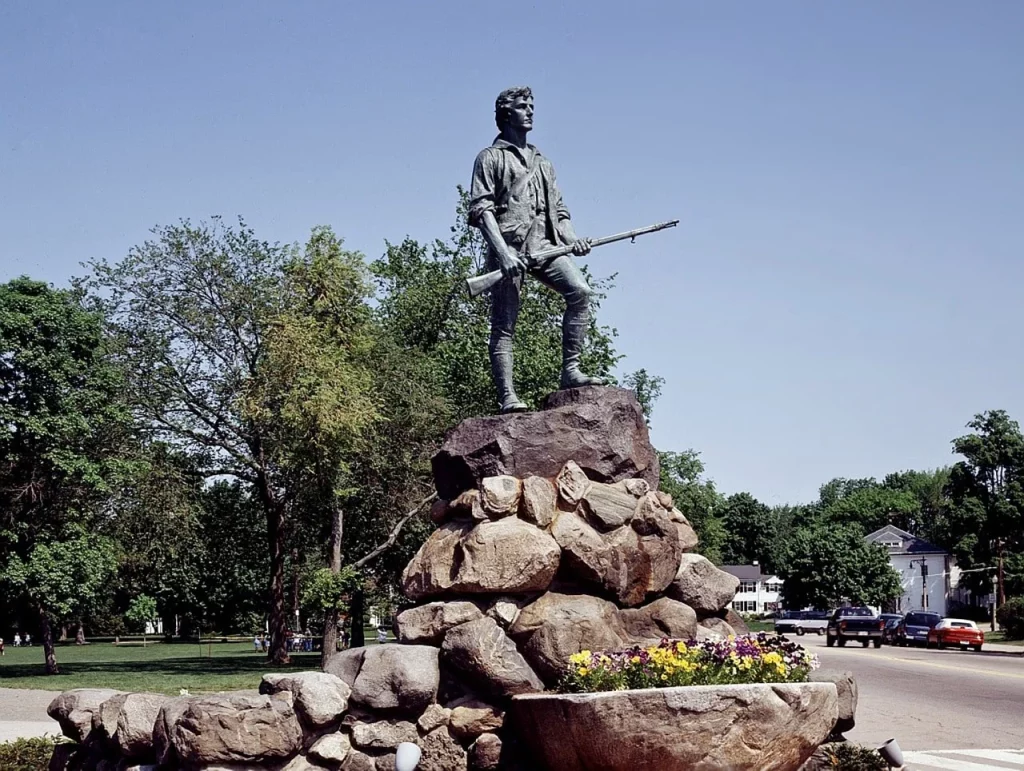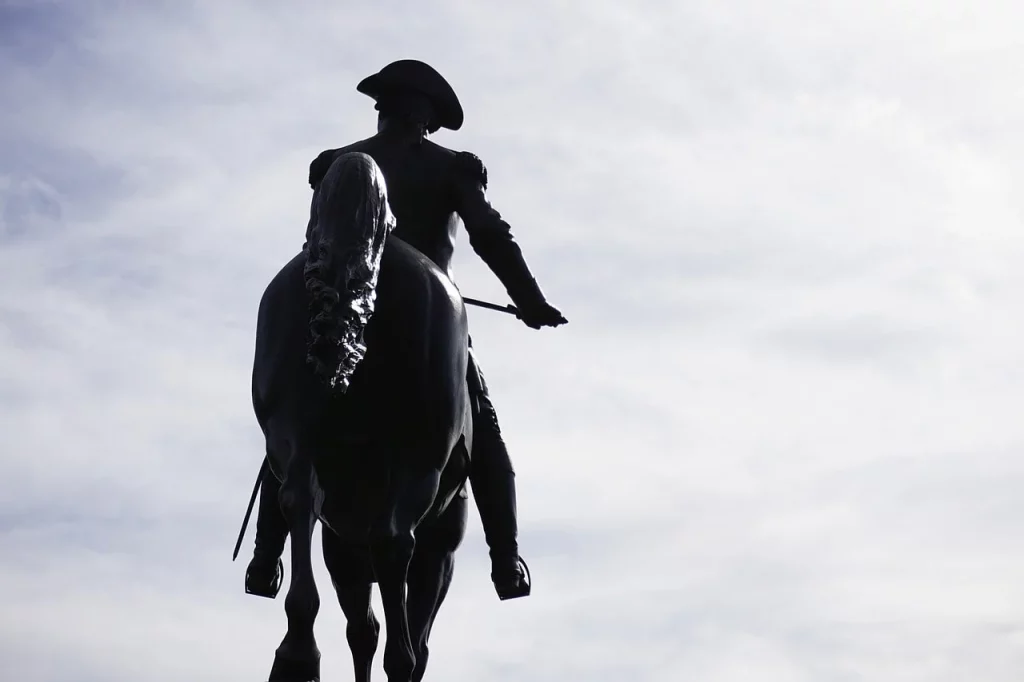The American Revolution reshaped the world in ways that still echo today. We are going to explore this seminal event’s wide-reaching impact, from the battlefields to the drafting of the Constitution.
You’ll gain insights into the revolution’s profound effect on global politics, society, and thought and meet the individuals who bravely fought for the ideals we cherish today. This article promises a deeper understanding of how a revolution from centuries ago continues to influence our lives.
Give me liberty, or give me death!
Patrick Henry
American Revolution Facts
Embark on a journey through the defining moments of the American Revolution. The facts ahead will not only enlighten you but also set the stage for the quiz at the article’s conclusion, challenging your grasp of this historical moment.
- The American Revolution began in 1775 and ended in 1783.
- Initially, the war was not fought for independence but for fairer treatment under British rule.
- The first battles were at Lexington and Concord on April 19, 1775.
- The Declaration of Independence was adopted on July 4, 1776.
- George Washington was appointed the commander-in-chief of the Continental Army.
- The Battle of Bunker Hill, although a British victory, showed that colonial forces could stand up to the British army.
- France played a crucial role by providing military support to the Americans after 1778.
- The Continental Congress functioned as the government of the 13 colonies during the war.
- Paul Revere’s famous midnight ride was to warn of approaching British forces.
- The Articles of Confederation were drafted during the Revolution as a basis for the new nation’s government.
- Women also played significant roles, serving as nurses, spies, and even soldiers in disguise.
- The Treaty of Paris in 1783 formally ended the war and recognized American independence.
- Approximately 25,000 American Patriots died during military service – the biggest loss of life.

- The British Empire employed German mercenaries, known as Hessians, during the war.
- Native American tribes were divided in support for the British and Americans.
- The Boston Tea Party was a protest against the Tea Act and British taxation.
- Valley Forge was where Washington’s army endured a harsh winter in 1777-78.
- The Battle of Saratoga was a turning point that gained French support for the American cause.
- African American slaves were promised freedom by both sides for participating in the war.
- The Stamp Act Congress in 1765 protested against British taxation without representation.
- John Adams, Benjamin Franklin, and John Jay negotiated the Treaty of Paris.
- The Sons of Liberty was a secret society formed to protect the rights of the colonists.
- Guerrilla warfare tactics were used effectively by American forces.
- The Continental Navy was established in 1775 to disrupt British supply ships.
- Ethan Allen and the Green Mountain Boys captured Fort Ticonderoga in 1775.
- The Olive Branch Petition was a final attempt by the colonists to avoid a full-scale war.
- Privateering, or privately-owned ships attacking British vessels, was a common practice.
- The Quebec Act of 1774 was seen as a threat to the autonomy of the colonies.

- Benjamin Franklin was instrumental in securing French aid for the Revolution.
- The Liberty Tree in Boston became a symbol of American resistance.
- Patrick Henry’s famous quote “Give me liberty, or give me death!” rallied colonial support.
- The Gaspee Affair in 1772 involved colonists burning a British customs ship.
- Marquis de Lafayette was a French nobleman who played a major role in the American victory.
- The Intolerable Acts were British laws passed in 1774 to punish Massachusetts for the Boston Tea Party.
- Thomas Paine’s pamphlet “Common Sense” helped sway public opinion in favor of independence.
- The Boston Massacre in 1770 was used as propaganda against the British.
- Spanish and Dutch involvement also aided the American cause.
- The Culper Spy Ring was a successful American intelligence network.

- Molly Pitcher is a folk hero who allegedly fought in the Battle of Monmouth.
- The First Continental Congress met in 1774 to address colonial grievances.
- Alexander Hamilton was an aide to George Washington and played a key role in the war.
- The Conway Cabal was a political intrigue against General Washington.
- John Paul Jones, a naval commander, famously declared, “I have not yet begun to fight!”
- The Daughters of Liberty was an organization of women who supported the boycott of British goods.
- The Battle of Yorktown in 1781 was the last major battle of the war.
- The British naval blockade severely impacted colonial trade and resources.
- Loyalists or Tories, remained faithful to the British Crown and faced persecution.
- The Powder Alarm of 1774 was a precursor to the armed conflict.
- Nathan Hale was executed by the British as a spy, and he is remembered for his famous last words.
- The Continental Currency was introduced to fund the war effort but suffered from inflation.
American Revolution Myths

After exploring interesting facts about the American Revolution, let’s now unravel the tales and separate historical truths from popular myths.
- The Revolution Was Supported by All American Colonists
In reality, the American colonies were deeply divided. A significant portion of the colonial population, known as Loyalists, remained faithful to the British Crown. The revolutionaries, known as Patriots, were not unanimously supported, leading to a complex and often fractious internal dynamic within the colonies. - The Boston Tea Party Was About High Taxes
The Boston Tea Party was more about the lack of colonial representation in the British Parliament than about high taxes. The famous slogan “No taxation without representation” reflects the colonists’ frustration over being taxed by a government in which they had no voice. - Paul Revere’s Midnight Ride Involved Shouting “The British Are Coming!”
Paul Revere likely never shouted “The British are coming!” during his midnight ride. Since many colonists still considered themselves British, such a statement would have been confusing. His message was more likely a discreet warning to specific Patriot leaders. - The American Revolution Was Primarily a Struggle for Liberty
While the quest for liberty was a key driver, the Revolution was also motivated by complex factors like economic interests, territorial expansion, and local politics. The struggle was as much about who would rule at home as it was about freedom from British rule. - The Declaration of Independence Was Signed on July 4, 1776
The Declaration of Independence was adopted on July 4, 1776, but it wasn’t signed by most of the delegates until August 2, 1776. The date July 4th has been memorialized as the official day of independence, but the signing was a more prolonged process.
No products found.
American Revolution Quotes

The American Revolution, a pivotal moment in history, not only shaped the United States but also left a profound impact worldwide. Here are some insightful quotes that capture the essence of this transformative period:
We must all hang together, or assuredly we shall all hang separately.
Benjamin Franklin
Spoken by Benjamin Franklin at the signing of the Declaration of Independence in 1776, this quote emphasizes the importance of unity and collective action among the American colonies.
These are the times that try men’s souls.
Thomas Paine
From Thomas Paine’s pamphlet “The American Crisis” (1776), this quote captures the challenging and pivotal moments of the American Revolution, inspiring courage and resilience.
I only regret that I have but one life to lose for my country.
Nathan Hale
Uttered by American spy Nathan Hale before his execution in 1776, this quote reflects his deep patriotism and willingness to sacrifice everything for the cause of American independence.
Don’t fire unless fired upon, but if they mean to have a war, let it begin here.
Captain John Parker
Said by Captain John Parker at the Battle of Lexington in 1775, this quote demonstrates the reluctant yet resolute spirit of American forces at the onset of armed conflict.
The tree of liberty must be refreshed from time to time with the blood of patriots and tyrants.
Thomas Jefferson
A stark reminder by Thomas Jefferson of the continuous struggle and sacrifice necessary to maintain freedom, highlighting the revolutionary spirit that underpinned the fight for American independence.
American Revolution FAQ

As we transition into the FAQ section, remember that these are your final insights before the upcoming quiz. So, read carefully to grasp every detail. Don’t disappoint me.
- How did the American Revolution start?
The American Revolution began as a conflict between the American colonies and Great Britain over issues of taxation and representation. The famous slogan “No taxation without representation” reflects the colonists’ frustration that they were being taxed by a British Parliament in which they had no elected representatives. The tension escalated with events like the Boston Massacre (1770) and the Boston Tea Party (1773), leading to the outbreak of war in 1775. - Who fought in the American Revolution?
The American Revolution was primarily fought between the thirteen American colonies and Great Britain. The colonists, later known as Patriots, sought independence from British rule. They were supported by various allies, notably France, Spain, and the Dutch Republic. On the British side, in addition to British troops, there were Hessian mercenaries and Loyalists—American colonists who remained loyal to the British Crown. - What were the key battles of the American Revolution?
Some key battles of the American Revolution include the Battles of Lexington and Concord (1775), which were the first military engagements of the war; the Battle of Bunker Hill (1775), which demonstrated that the inexperienced colonial forces could stand up to the British army; the Battle of Saratoga (1777), a turning point that brought French support to the American cause; and the Siege of Yorktown (1781), where British General Cornwallis’s surrender effectively ended the war. - What was the significance of the Declaration of Independence?
The Declaration of Independence, adopted on July 4, 1776, was a pivotal document in the American Revolution. Drafted primarily by Thomas Jefferson, it declared the thirteen American colonies independent from British rule. The Declaration articulated ideals of individual liberty and government by the consent of the governed, which profoundly influenced both the development of the United States and democratic movements worldwide. - How did the American Revolution impact other countries?
The success of the American Revolution had a profound impact globally. It inspired other revolutionary movements, most notably in France, leading to the French Revolution. The ideals of liberty, democracy, and national self-determination that emerged from the American Revolution influenced political thinking and movements in Europe and Latin America throughout the 19th century, playing a significant role in shaping the modern world.
No products found.
American Revolution Quiz

Welcome to the American Revolution quiz! If you don’t get a single question right, be prepared to be ‘taxed’ with a barrage of more history quizzes!
Conclusion
From the first shots fired in Lexington to the final signatures on the Treaty of Paris, the American Revolution was a testament to resilience and conviction.
The echoes of it still resonate today, reminding us of the power of collective action and belief in a cause. Which revolutionary figure do you find most inspiring, and how do their ideals speak to you? Let me know in the comments.
4 Sources Used For This ArticleThe American Revolution – Slideplayer
Major Battles Of The American Revolutionary War – World Atlas
American War of Independence: Outbreak – Nam


